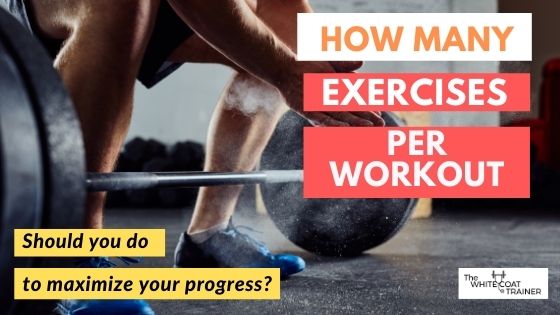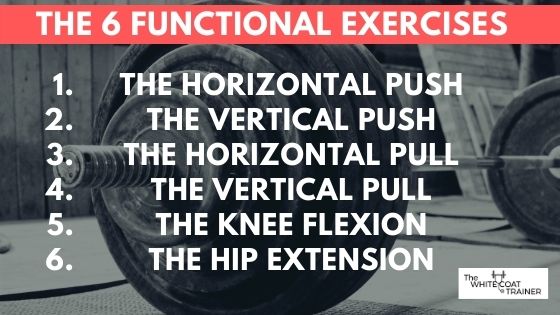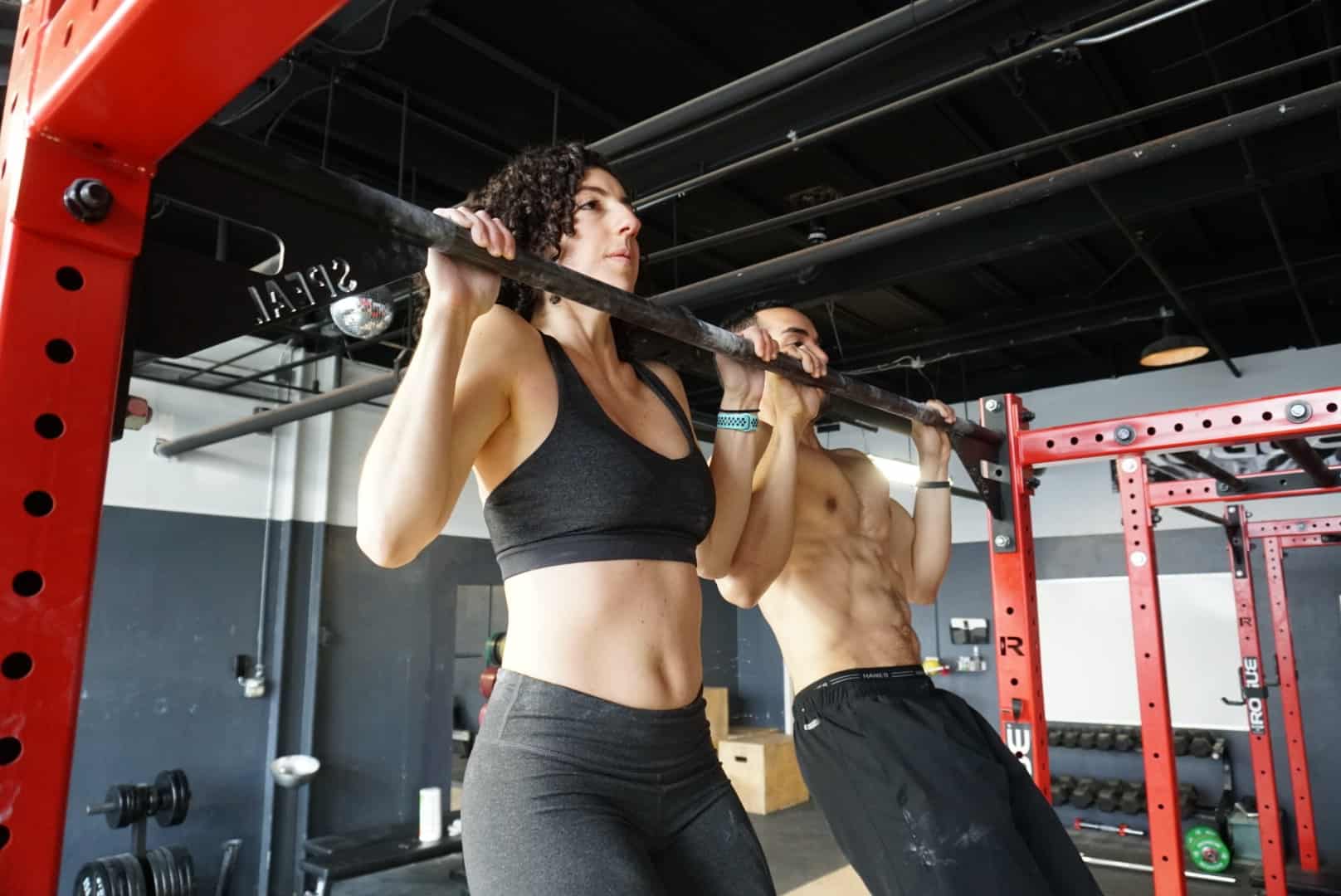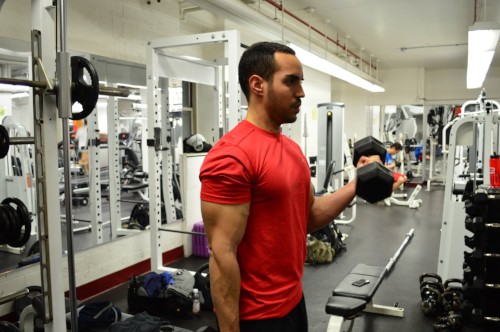Have you ever thought to yourself, “how many exercises per workout do I need to do?”
If so, you are in the right place.
If you do too many exercises, you run the risk of injury and unnecessary fatigue. If you do too little, you might not make any progress at all.
Today, you are going to learn:
- how many exercises per workout you should do
- how many exercises per muscle group you should do
- and how to structure your workouts to maximize the little time you have to exercise.
Keep reading.

How Many Exercises Per Workout Session Should I Do?
The ideal number of exercises per workout session is 3-4 exercises.
If you select your exercises appropriately and train them with sufficient volume and intensity, this will be more than enough to make great progress.
This means:
- Focusing on an 80/20 split of compound to isolation exercises
- Performing at least 15 total repetitions of each exercise per workout
- Lifting a weight that is heavy enough to induce muscular fatigue, and
- Training each major muscle group twice a week
Believe it or not, you can accomplish all four of these bullet points with just 3-4 exercises per day.
This holds true even if your goal is weight loss, build muscle mass, or improve your health and fitness
Why 3-4 Exercises Per Session Is Ideal
Focusing on fewer exercises per day is critical because it forces you to focus on what really matters.
Many workout programs include far too many exercises, which can become counterproductive.
When you do 5 or 6 exercises per workout, you run the risk of:
Focusing on less important exercises
- There are only a handful of exercises you really need to do to maximize muscle gain or strength gain
- By doing more than 4 exercises, you are very likely to do low yield exercises that aren’t a great investment of your time.
Your workouts becoming too long
- I don’t know about you, but I don’t always have an hour to spend at the gym.
- Believe it or not, you don’t need to exercise longer than 30-45 minutes per day.
Increased fatigue
- If you program your workouts correctly, you won’t have a lot of energy left over after 4 exercises.
- The 5th and 6th exercises of the day will be mediocre at best.
How Many Exercises Per Muscle Group Should You Do?
The next question is- how many exercises should you do per muscle group?
In general, you should do approximately 2 exercises per muscle group, and train each muscle group two times a week.
With that said, you need to ensure that you’re training all the larger muscle groups, which are:
- The chest muscles,
- The shoulders,
- The arms (triceps and biceps)
- The back (rhomboids, traps, and lats)
- The quadriceps
- The hamstrings
- The glutes
Plus, there are other smaller muscle groups in the forearms, calves, and rotator cuff.
Here is a simple muscle chart just to give you an idea.

As you can see, it is difficult to train all the large muscle groups twice per week if you only do 3-4 exercises per workout.
So how do we overcome this issue?
You pick the best exercises that train multiple muscle groups at once.
The Best Exercises To Train All The Major Muscle Groups
Your body is meant to function as a unit.
Whenever you lift an object, climb stairs, or bend down to tie your shoes, your body recruits many muscle groups at once to perform the task.
That is why you shouldn’t focus on muscle groups. Instead, you should focus on movement patterns.
All in all, there are only 6 basic movement patterns that you need to do.
- A Horizontal Push: Such as the bench press and the push-up
- A Horizontal Pull: Such as the barbell row and the inverted row
- A Vertical Push: Such as the overhead press and the handstand push-up
- A Vertical Pull: Such as pull-ups and lat pulldowns
- A Knee Dominant Movement: Such as squats and lunges
- A Hip Dominant Movement: Such as deadlifts and hamstring curls
If you focus the majority of your time on these, you will be training just about every single muscle in your body.
That way, you can accumulate a lot of training volume for multiple muscle groups.
The best part?
Among those 6 movement patterns, there are several exercises you can choose from, so you can find something that is suitable to your fitness level and training experience.

Any other exercise such as bicep curls, tricep extensions, and shoulder raises are simply icing on the cake.
At least 80% of the exercises in your program must be composed of these 6 basic movement patterns.
So how do you program your 3-4 exercises per day?
In the next section, you will learn how.
Keep reading.
Section Recap:
- 3-4 exercises per workout is enough to accomplish your fitness goals
- If you program your workout correctly, more than 4 exercises per day can become counterproductive
- You only need to focus on 6 major movement patterns when selecting your exercises
What Exercises Should You Include In Your Workout Session?
In this next section, let’s go over how to design a workout to target all the different muscle groups appropriately.
You will need
- One primary compound exercises per workout
- Two to three secondary exercises per workout
The Primary Compound Exercise
When designing your strength training program, you should only have one primary compound exercise per day.
Why?
Because the main exercise will be both the heaviest and the hardest lift you are going to do that day.
When you know that every subsequent exercise after the main exercise will be “easier,” you will give the main movement more focus.
That is why the primary movement has to be one of the best/ most effective exercises.
Let’s go over them.
What Constitutes A Primary Exercise?
The primary exercise should meet three criteria:
- It should train as many muscle groups as possible
- It should be an exercise you can progressively overload easily
- It should ideally be performed with a barbell
The best of the best are exercises that are close variations to the big four and the vertical pull
- Squats,
- Deadlifts,
- Bench Presses,
- Overhead Presses, and
- The Pull-up
These are the top five exercises for muscle growth!

You can and should find a variation that you can do with a full range of motion, and without pain.
Here are some common examples:
Main Squat Variations:
Main Deadlift Variations:
Main Bench Pressing Variations:
Main Overhead Pressing Variations:
Main Pull-Up Variations:
Pick one variation of the first four to design four different workouts.
You will then select a main pull-up variation that will also be done on 1-2 of those workouts.
If you cannot perform any of these primary exercises, then I will show you how to make some modifications. More on that below.
Okay, so now you have your main exercises selected. Let’s go over the secondary exercises to include in your workout.
The Secondary Exercises
After you select the main exercises you want to do, you then have to choose secondary exercises.
The secondary exercises will do three things
- Focus on easier variations of the main exercises (i.e. using lighter weight)
- Isolate any weak points or help you target smaller muscle groups
- Add variety by giving you different exercises to train the same muscle groups but from a different angle
Here are a few examples of secondary exercises:
Secondary Squat Variations:
Secondary Deadlift Variations:
Secondary Bench Pressing Variations:
Secondary Overhead Pressing Variations:
Secondary Pull-Up Variations:

As you can see, the secondary exercises are designed to be less taxing than the primary exercise.
You could even use bodyweight exercises.
As such, you can perform secondary exercises as a superset, and with a shorter rest period.
Choose 1 exercise from each category to be your secondary exercise.
Got them? Good.
By the way, be sure to check out our mini e-book that goes over all of the best compound exercises for each muscle group to include in your workout plan.
What If I Can’t Do One Of These Big 5 Exercises?
You may not be able to do one of these big 5 exercises for one reason or another.
So what do you do when you can’t perform one or more of the big 5 primary exercises?
This is how to modify your workout.
- Select a secondary exercise to be treated as the primary exercise
- Whatever exercise you select as your primary exercise, you will go “heavier” than usual
- This means using heavier weights that allow you to work in the 6-8 rep range
- You will also perform an additional set of that primary exercise
- I.e, if you are normally doing 3 sets of each exercise, do 4 for the primary exercise
You can also include exercises not mentioned above.
Just make sure that you are using compound lifts more than 80% of the time.
The Complete List Of The Best Compound Exercises
If you want to see a complete list of exercises that can be your main exercise or your secondary exercises, check out my complete list of 46 compound exercises that build muscle mass efficiently.
These exercises have been hand-selected to be some of the most useful variations you can choose from.
There will be a variation for everyone.
Section Recap:
- Focus on one primary exercise per workout
- A primary exercise should train as many muscle groups as possible
- Select 2-3 secondary exercises to include per workout
- These Secondary exercises should still train the 6 major movement patterns but are not as taxing (i.e dumbbell exercises or bodyweight exercises.)
How To Structure Your Workout Using 3-4 Exercises Per Session
Ok here comes the fun part.
Now that you have selected your primary and secondary exercises, it is time for you to start creating your program.
In order to do so, you need to know which workout split you are going to use.
The 3 Types of Workout Splits
What is a workout split?
A split refers to how your workouts are divided. In general, there are only three that you should consider.
The Upper Body / Lower Body Split:
- You can choose to train all of the major upper body movements on one day, followed by all of the major lower body splits on another. You should consider this split if you are an intermediate.
The Full Body Split:
- In the full-body split, you mix and match exercises from both the upper body muscle groups and the lower body muscle groups into the same session. You aren’t necessarily training every single muscle in your body- but you are hitting a lot at once. You should consider this split if you are a beginner.
The Push-Pull Split:
- The third option is the push-pull split. You train all of the pushing (or pressing muscles) on one day, and all of the pulling muscles on another. This is another variation of the full-body split.
You cannot go wrong with either of these three approaches. In order to learn which one you should do, check out our complete article on the topic here.
P.S. *I don’t recommend the traditional bodybuilding workouts split where you train 1 muscle group per day. This is the most inefficient way to train.
However, if your goal is purely to get big muscles, a bodybuilding split can be beneficial. Either way, I suggest you focus on building stronger muscles first.*

How Many Times Should You Train Each Body Part Per Week?
Now that you have your training split selected, what training frequency should you use?
In other words, how many workouts per muscle group, or how many times a week should you train each body part?
A recent meta-analysis of 25 studies tried to answer this question.
They found that there was no significant difference in muscle mass between training each body part 1, 2, or 3 times per week, provided the total weekly training volume was equated amongst the groups.
With that in mind, this study only focused on hypertrophy (aka muscle size), and not necessarily on strength gain which cannot be ignored.
In my opinion, it is better to train each muscle group more than once per week as trying to do a lot of volume in one session will lead to
- Long workouts
- Increased fatigue
- Increased risk of injury to your joints or muscle tissue
Therefore, I suggest you train each body part twice per week.
Here’s A Sample Of What Your Weight Training May Look Like
Here is a sample workout of what your program may look like.
This is a four-day-a-week upper/lower workout split training 4 days a week.
Workout 1
- Primary Exercise: Front Squat 3 x 8 repetitions
- Secondary Exercise A1: Dumbbell Romanian Deadlift 3 x 10 repetitions
- Secondary Exercise A2: Bulgarian Split Squat 3 x 8 repetitions each leg
- Secondary Exercise B: Ab Wheel Rollouts 3 x 12 repetitions
Workout 2
- Primary Exercise: Incline Bench Press 3 x 10 repetitions
- Secondary Exercise A1: Pull-ups 3 x 6 repetitions
- Secondary Exercise A2: Pike Push-ups 3 x 10 repetitions
Workout 3
- Primary Exercise: Romanian Deadlift 3 x 8 repetitions
- Secondary Exercise A1: Lunge 3 x 8 repetitions each leg
- Secondary Exercise A2: Back Raises 3 x 8 repetitions
- Secondary Exercise B: Hanging Leg Raises 3 x 10 repetitions
Workout 4
- Primary Exercise: Dumbell Overhead Press 4 x 8 repetitions
- Secondary Exercise A1: Horizontal Pull-ups 3 x 8 repetitions
- Secondary Exercise A2: Dumbbell Bench Press 3 x 10 repetitions
There are a few things to note on this sample program
- Each major muscle group is trained ~2 times per week
- Secondary Exercise A1 is super-setted with Secondary Exercise A2 to save time
- In Workout 4- The Dumbbell Overhead Press (which is generally considered a secondary exercise) is chosen as the Primary exercise
- As a result, we do 4 sets instead of 3
Section Recap:
- Choose one of the major training splits to structure your workouts around
- Aim to train each major muscle group 2 times per week
- Superset all secondary exercises to save time
Other FAQs/Considerations
How Many Reps Should I Do Per Workout?
I recommend that you do work in the 5-12 rep range for the vast majority of your training.
Anything above 12-15 reps will train muscular endurance.
Whatever rep range you choose, just make sure that you stick to that range for at least 4-6 weeks and stay consistent per exercise.
For example, if you do the squat for 3 sets of 8 repetitions, do not jump to 3 sets of 3 the following week and then 3 sets of 12 the next. Keep the reps relatively stable per exercise.
This will give you enough time to maximize your strength and muscle growth in that rep range.
We have written an entire article on training volume and the optimal number of reps you can do here.
How Many Sets Should I Do Per Workout?
I recommend that you do anywhere from 3-5 sets per exercise.
A set is a group of consecutive repetitions. If you are low on time, stick with 3 sets, and do supersets.
We cover this in greater detail in our post about sets/reps.
What If I Want To Add More Exercises?
What if you want to do more than 3-4 exercises per day?
That’s fine.
Just start slow. Do 3-4 exercises for a week or two and see how you feel. If you feel really fresh, and want to do more exercises per day, then start by adding one more.
Just make sure that your body can handle 5 exercises per day (and make sure that you actually have the time to do this many exercises as well).
How Many Exercises Are Too Many?
A lot of magazines will show you routines with 6 or 7 exercises per day.
I don’t know about you, but I don’t have 2 hours to spend at the gym.
I would not do more than 5 exercises per workout.
What If I Only Want To Build A Specific Muscle?
Building muscle tissue requires repeated exposure to resistance training.
Instead of mixing and matching exercises per workout, you will center your secondary exercises around that specific muscle group.
Ideally, you will target that specific muscle with one large primary compound exercise, followed by 1-2 secondary exercises that further train that muscle.
It is okay to use 1-2 isolation exercises per day to target your specific muscle, provided you have done a compound primary exercise.
For example:
Let’s say you really want to build your biceps.
You will do 2-3 biceps focused exercises per workout, twice per week.
Here’s how:

Bicep Workout 1
- Primary Exercise: Weighted Chin-ups 3×8 repetitions
- Secondary Exercise A: Barbell Curls 3×10 repetitions
- Secondary Exercise B: Seated Cable Rows 3×8 repetitions
*Note: You do not superset the secondary exercises as they are training similar muscle groups.
Bicep Workout 2
- Primary Exercise: Barbell Row 3×8 repetitions
- Secondary Exercise A: Preacher Curls 3×10 repetitions
- Secondary Exercise B: Close Grip Push-ups 3×8 repetitions
*Note: Push-ups are included here to train the antagonistic muscle, the triceps. This helps to prevent muscular imbalances.
How Many Workouts Per Day Should I Do?
Unless you are specifically competing in some type of sport, I do not recommend that you work out more than once per day.
As a busy professional, it is hard enough to go once per day four times a week.
However, if you are a competitive athlete, it can be beneficial to exercise twice per day. Your coach can help tailor a workout program that involves twice-a-day training.
- Common examples include resistance training in the AM, followed by an eundrance training in the PM.
A Simple Full Body Workout That Includes The Right Number of Exercises
Okay, so now you can use this information to start designing your workout program.
Or, you can bypass all that work and let us do the work for you.
The WCT Strength Program already takes all of these principles into consideration and provides you an easy to follow 15-week template.
This template tells you how many exercises you should do per workout, what exercises to do, how many sets and reps you should do, and how to increase the weight.
There is a male template and a female template.
In Summary… How Many Exercises Per Workout and Per Muscle Group Should You Do?
To sum it all up, when designing a weight lifting strength program:
- Do 3-4 exercises per workout per day
- Rather than focusing on how many exercises per muscle group, focus on training movement patterns instead
- There are only 6 major movement patterns you need to train
- Choose 1 primary exercise and 2-3 secondary exercises
- Your primary exercise should be one of the “Big 5”
- Your secondary exercises should complement the Big 5
- Design your workout to hit each major muscle group two times per week
That’s all I have for you today.
Next, you should read:
- How Long Should Your Workout Be?
- The Best Full-Body Workout Template For Busy People
- How Many Sets & Reps Should You Do?
Now we turn it over to you.
How many exercises do you do in your workout?
Are your workouts too long?
Comment below and let us know!

Alex Robles, MD, CPT / Brittany Robles, MD, MPH, CPT
Alex & Brittany Robles are physicians, NASM CPTs, health & fitness experts, and founders of The White Coat Trainer: a site dedicated to improving the health and fitness of busy professionals. Their advice has been featured on KevinMD, The Doctor Weighs In, My Fitness Pal, Reader’s Digest, Livestrong, and The Active Times. Learn more about them here.


Hey, great article. I’m trying to get back into my workout routine, although I don’t really have the time or motivation to go the the gym. I do however have a bench and dumbells (10-60lbs) at home. I do not have an Olympic bar either although I have been looking into getting a foldable wall mounted squat rack with bar. For now, I’d like to just get back into the rythme. Any suggestions on what I could change in your split workout with the limited equipment I currently have? Any suggestions would be appreciated!
Thanks,
Jon
Hey Jon,
Thanks for your comment. You are definitely on the right track.
To be totally honest, the variations of the exercise you perform don’t matter as much as you simply doing them consistently. (I.e, if you don’t have a rack or a barbell that’s ok)
With that said, here are some suggestions.
Primary Exercise: Front Squat- substitute Box Squats (holding onto dumbbells and squatting onto the bench) check this video out https://whitecoattrainer.com/blog/box-squat
Secondary Exercise A1: Dumbbell Romanian Deadlift (you can do)
Secondary Exercise A2: Bulgarian Split Squat (you can do with your bench)
Secondary Exercise B: Ab Wheel Rollouts (you can get one cheap on Amazon)
Workout 2
Primary Exercise: Incline Bench Press- substitur Incline Pike Push – (see it in this post – https://whitecoattrainer.com/blog/bodyweight-shoulder-exercises – to make it more challenging, you could add paralletes, or something to increase the range of motion
Secondary Exercise A1: Pull-ups 3 x 6 repetitions (there are many options such as iron gym, screw-on pull-up bars, towers, etc)
Secondary Exercise A2: Push-ups 3 x 10 repetitions
Workout 3
Primary Exercise: Romanian Deadlift (you could do them again with dumbbells)
Secondary Exercise A1: Lunge (you could do)Secondary Exercise A2: Back Raises – substitute with Prone Cobras (i dont have a link but you can find on google)
Secondary Exercise B: Hanging Leg Raises- substitute with reverse crunch progressions as seen here https://whitecoattrainer.com/blog/dragon-flags
Workout 4Primary Exercise: Dumbell Overhead Press (you could d0)
Secondary Exercise A1: Horizontal Pull-ups (instead you could do dumbbell row like this video – https://whitecoattrainer.com/blog/dumbbell-row
Secondary Exercise A2: Dumbbell Bench Press (you could do)
Hope this helps
Your exercise program makes sense for an 82 year male. Thanks for a new approach to my life.
You’re welcome Bob. I’m glad you found it useful!
Great post here, would it be possible to do all compound excersises?
At the moment one of my plans is
Day one
Floor barbell press (dont have a squat rack)
Bent over barbell rows
Standing barbell press
Chin ups
Day two
Goblet squats
Romanian dead lift
Kettle bell swings
Ab rollover
Day three
Inc one arm dbell press (only way to get them heavy enough)
Bent over row dbell
Curls to shoulder press
Press ups
Day four
Deadlift
Bulgarian squats
Calf raises
Farmers carry
Have you anything that could help to make it better?
That plan looks pretty good.
Give it a go and see how long the workouts take and how your body feels afterward.
Do you have any way to progressively overload the exercises over time? (I.e add 5 lbs to each exercise here and there etc) if not, you can simply add more reps, slow down the tempo, or do a slightly harder variation.